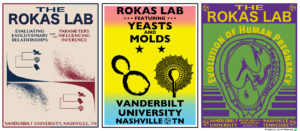A bird’s beak or a whale’s flipper contains information not only its function but also about its history. Similarly, information stored in DNA includes not only instructions about a cell’s function or the transformation of an egg into an embryo, but also a record of the organism’s biological past, and its history of change and adaptation. Far from the prevailing notion of the genome as a “blueprint”, the DNA of any organism more likely resembles a continually edited palimpsest, assembled over 3.5 billion years, whose sequence of letters contains important clues to major organism features that are largely yet to be deciphered. In the Rokas lab, we study the DNA record to gain insight into the patterns and processes of evolution, focusing on three major questions:
I. How can we elucidate the tree of life?
II. What are the molecular foundations of the fungal lifestyle?
III. How did human pregnancy evolve?
We are working with several eukaryotic lineages, but mainly with mammals and fungi. Because, many of the computational and experimental approaches we employ are novel and unfamiliar to many biologists, we also investigate their utility for studying the function and evolution of the genomes of non-model organisms.
